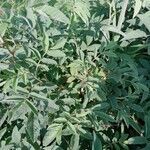Shrubs 1–3 m tall. Branchlets red-brown or purple-brown, terete, slightly curved, glabrous; prickles sparse to dense, terete, straight, to 4 mm, fine, evenly tapering to small base. Leaves including petiole 7–14 cm; stipules mostly adnate to petiole, free parts broadly ovate, abaxially pubescent, margin glandular serrate, apex acuminate; rachis and petiole pubescent, glandular-pubescent, and sparsely prickly; leaflets 3–7, broadly elliptic or oblong, 1.5–5 × 0.8–2.5 cm, abaxially pubescent, with prominent midvein and lateral veins, adaxially glabrous, with slightly concave midvein and lateral veins, base subrounded, rarely broadly cuneate, margin simply serrate or inconspicuously doubly serrate, apex acute or rounded-obtuse. Flowers solitary, or 2 or 3 and fasciculate, 3.5–5 cm in diam.; pedicel 2–3.5 cm, densely glandular-pubescent; bracts ovate or ovate-lanceolate, margin glandular serrate or incised, apex acuminate or caudate. Hypanthium ellipsoid, usually glabrous, rarely glandular-pubescent. Sepals 5, lanceolate, leaflike, abaxially pubescent, glandular, and sparsely bristly, adaxially densely pubescent, margin entire. Petals 5, pink, rarely white, fragrant, obovate, base broadly cuneate, apex emarginate. Styles free, shorter than stamens, pubescent. Hip red, pyriform, long ellipsoid, or obovoid, 1–1.5 cm in diam., with a distinct neck, shiny, glabrous or rarely slightly glandular, with persistent, erect sepals. Fl. Jun–Jul, fr. Jul–Sep. 2n = 28, 56.
Colonial; stems to 1(–2) m, usually densely beset with straight, slender, unequal prickles, even on the flowering lateral branches; stipules pubescent, glandular on the margin, when young densely covered with short-stipitate glands, as also the bracts; rachis usually pubescent and glandular; lfls 5 or 7(9), elliptic to ovate or obovate, 1.5–4.5(–8) cm, usually doubly serrate, often glandular; fls usually solitary on lateral branches from stems of the previous year; hypanthium and pedicel glabrous, or the pedicel seldom stipitate-glandular; pet pink or deep rose, 1.5–3 cm; sep persistent, becoming erect and connivent; hips 1–2 cm thick, dark blue or purplish; 2n=42. Upland woods, hills, and rocky banks; N.B. and Que. to Alas. and Eurasia, s. to W.Va., Mich., nw. Ill., Io., and N.M. The Amer. plants, as here described, are var. bourgeauiana Crép., or subsp. sayi (Schwein.) W. H. Lewis. (R. bourgeauiana; R. sayi)
A shrub. It grows 1.8 m high and spreads 1.2 m wide. It has many prickles. The leaves are greyish-green. There are commonly five leaflets. The flowers are deep pink and have a mild scent. They occur singly. The fruit are bright red, pear shaped hips.


